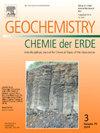西北非洲4757不寻常的CY碳质球粒陨石的变质作用和水蚀变
IF 2.9
3区 地球科学
Q2 GEOCHEMISTRY & GEOPHYSICS
引用次数: 0
摘要
研究了第一个来自西北非洲地区的CY球粒陨石(NWA 4757)。它是一种小的(5克)细粒单粒微角砾岩,由丰富的基质(约95 vol%)和罕见的假晶球粒(高达200 μm)组成。该陨石具有CY球粒陨石的主要特征。NWA 4757的氧同位素组成为16O-poor (δ18O = 23.83, δ17O = 12.84, Δ17O = 0.45 ~ δ18O = 26.96, δ17O = 14.50, Δ17O = 0.48±0.03),是CY球粒陨石中最重的。NWA 4757含有丰富的硫化物(约20 vol%),与CM球粒陨石相比,它的整体化学成分富含硫,就像大多数其他CY球粒陨石一样,除了Dhofar 225和Dhofar 735。NWA 4747在受热变质作用影响之前,受岩石学1.0型的强烈水蚀变影响。在NWA 4757中,只有几粒未变质的橄榄石(Fa10)幸存下来。与其他CYs相比,NWA 4757的三黄铁矿富锰。矩阵在纹理和组成上分为浅色和深色两种类型。与暗基质相比,光基质富钙,贫铁。脱水层状硅酸盐具有蛇纹石组成,皂石含量较低,如CY2s。高镍金属和硫化物、铬铁矿和钛铁矿的存在以及磁铁矿的缺失表明,在平衡条件下,NWA 4757母体蚀变体系的氧化还原状态不超过铁-浮氏体缓冲带的逸度。在水蚀变后,NWA 4757经历了强烈的热变质作用,导致与通常的CI和CM球粒陨石相比,H2O含量较低(1.9 wt%)。对NWA 4757和Mighei (CM2)基体的傅里叶变换红外光谱(FT-IR)分析表明,NWA 4757基体以富铁细粒橄榄石为主。根据基于x射线粉末衍射(XRD)数据的热变质水合碳质球粒陨石分类体系,NWA 4757与CY2s一样处于加热阶段IV (>750℃)。由于方解石(甚至白云石)在变质作用中幸存下来,应该说明峰值温度不高于800℃。因此,NWA 4757是第一个具有变质前极蚀变CM1球粒陨石性质的热期IV (CY2) CY球粒陨石,推测应为CY2-m1。本文章由计算机程序翻译,如有差异,请以英文原文为准。
Metamorphism and aqueous alteration of the unusual CY carbonaceous chondrite Northwest Africa 4757
The first CY chondrite from the Northwest Africa region was studied (NWA 4757). It is a small (5 g) fine-grained monomict microbreccia consisting of abundant matrix (∼95 vol%) and rare pseudomorphic chondrules (up to 200 μm). The meteorite has main characteristics of CY chondrites. The oxygen isotopic composition of NWA 4757 is 16O-poor (δ18O = 23.83, δ17O = 12.84, Δ17O = 0.45 to δ18O = 26.96, δ17O = 14.50, Δ17O = 0.48 ± 0.03) which is the heaviest among other CY chondrites. NWA 4757 contains abundant sulfides (∼20 vol%) and its bulk chemical composition is enriched in sulfur compared to CM chondrites like most other CY chondrites except for Dhofar 225 and Dhofar 735.
NWA 4747 was affected by very intensive aqueous alteration corresponding to petrologic type 1.0 before it was affected by thermal metamorphism. Only a few grains of unaltered olivine (Fa10) survived in NWA 4757. In contrast to other CYs, troilite from NWA 4757 are Mn-rich. The matrix is divided into light and dark types in texture and composition. The light matrix is Ca-rich, and Fe-poor compared to the dark matrix. The dehydrated phyllosilicates had serpentine composition with a low saponite content like CY2s. The presence of high-Ni metal and sulfides, chromite and ilmenite and absence of magnetite indicate that under equilibrium conditions, the redox state of the alteration system in the NWA 4757 parent body did not exceed the fugacity of the iron-wustite buffer.
After aqueous alteration NWA 4757 experienced intensive thermal metamorphism resulting in a low H2O (1.9 wt%) compared to usual CI and CM chondrites. The Fourier Transform Infrared (FT-IR) spectroscopy of the matrices of NWA 4757 and Mighei (CM2) showed that the NWA 4757 matrix is dominated by Fe-rich fine-grained olivine. According to a classification system for thermally metamorphosed hydrated carbonaceous chondrites based on X-ray Powder Diffraction (XRD) data, NWA 4757 is characterized by heating stage IV (>750 °C) like CY2s. Since calcite (and even dolomite) survived metamorphism, it should indicate that the peak temperature was not higher than 800 °C. Thus, NWA 4757 is the first CY chondrite of thermal stage IV (CY2) which had properties of extremely altered CM1 chondrite before metamorphism and suggestively should be CY2-m1.
求助全文
通过发布文献求助,成功后即可免费获取论文全文。
去求助
来源期刊

Chemie Der Erde-Geochemistry
地学-地球化学与地球物理
CiteScore
7.10
自引率
0.00%
发文量
40
审稿时长
3.0 months
期刊介绍:
GEOCHEMISTRY was founded as Chemie der Erde 1914 in Jena, and, hence, is one of the oldest journals for geochemistry-related topics.
GEOCHEMISTRY (formerly Chemie der Erde / Geochemistry) publishes original research papers, short communications, reviews of selected topics, and high-class invited review articles addressed at broad geosciences audience. Publications dealing with interdisciplinary questions are particularly welcome. Young scientists are especially encouraged to submit their work. Contributions will be published exclusively in English. The journal, through very personalized consultation and its worldwide distribution, offers entry into the world of international scientific communication, and promotes interdisciplinary discussion on chemical problems in a broad spectrum of geosciences.
The following topics are covered by the expertise of the members of the editorial board (see below):
-cosmochemistry, meteoritics-
igneous, metamorphic, and sedimentary petrology-
volcanology-
low & high temperature geochemistry-
experimental - theoretical - field related studies-
mineralogy - crystallography-
environmental geosciences-
archaeometry
 求助内容:
求助内容: 应助结果提醒方式:
应助结果提醒方式:


